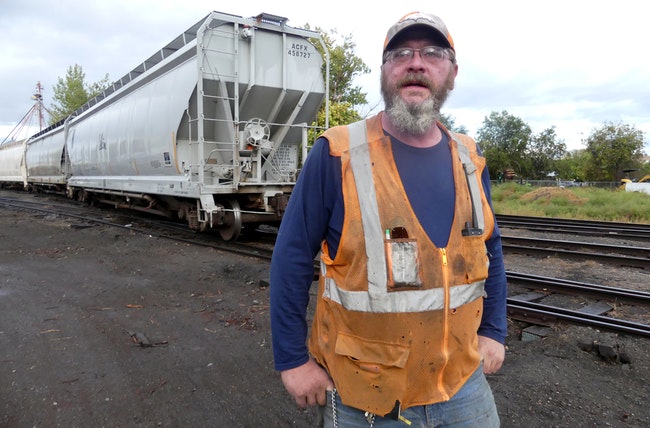
Wayne DeLong views the Vale-based train operation with pride. (The Enterprise/Pat Caldwell)
VALE – The rain was just beginning to clear Friday morning as Wayne DeLong, the operations manager for the Oregon Eastern Railroad, watched the big blue locomotive engine roll past the crossing at 12th Street North.
As the locomotive – dubbed an EMD GP7 – sounded its horn, DeLong nodded toward the big diesel engine.
“She’s not pretty looking, but she sure runs well,” he said.
DeLong, who manages an Oregon Eastern crew of six, was on hand at the rail yard on Railroad Avenue to supervise a switch out of cars.
“This little job here will probably take half an hour to grab a car,” he said.
The “little job” involved an effort to move a recently inspected and repaired bulk hopper rail car out of its resting place at the yard and connect it to a train.
If you didn’t know where to look it might be hard the find the local headquarters for the railroad. The headquarters building sits right next to the Vale Liquor store at 164 Washington St., E. There is no flashy sign advertising the railroad, just an American flag in the window. Inside, the office showcases a neat, 1980s-era décor where DeLong and other crewmembers congregate from time to time. Mostly, though, they spend their time on the tracks.
There are no massive railroad round houses to store the firm’s two EMD GP7’s engines or other rail cars. Repairs and inspections are completed right on the rails next to a warehouse owned by Dentinger Feed & Seed.
While DeLong watched, conductor Chad Fulk, walked up to a black metal pole topped with a bright red round sign, pulled down a lever and twisted. The pole – or switch – turned the rails so the blue engine could drive down and hook up to the bulk hopper.
Fulk then drove south, across the 12th Street North to where the blue engine idled behind a half-dozen other bulk hopper cars.
[ KEEP YOUR LOCAL NEWS STRONG – SUBSCRIBE ]
After another rail switch was turned, the engine travelled down and connected to the inspected car. Fulk stood near the repaired hopper and guided the train to a connection using a radio to communicate with the engine.
The quiet, soft-spoken DeLong watched in silence but after a while he pointed to the train.
“We’ve not had a reportable injury in 10 years,” he said with pride.
DeLong and Fulk and the four other members of the Oregon Eastern Railroad represent a business with deep local roots that traces its lineage – in one way or another – back more than 100 years.
“It was originally constructed as a through-line to Burns by Union Pacific back in the early part of the last century,” said Bruce Carswell, senior vice president for the railroad.
The railroad connected to Burns in the mid-1920s.
“In that era when it was built it was about 130 miles long and served the agriculture needs of Malheur County and, ultimately, the main business in Harney County, which was timber,” said Carswell.
The railroad mostly catered to the Hines Lumber Company in Hines up until the early-1980s.
That’s when a sequence of extremely wet years bloated Malheur, Harney and Mud Lakes, which damaged the rail tracks.
“For a number of years, it was out of service to Burns,” said Carswell.
Eventually the water receded but the railroad remained out of service, said Carswell.
“Union Pacific decided to get rid of it about the same time Harney Lake went down and the railroad was able to have reliable service, but Union Pacific didn’t want to spend the money to redo the tracks,” said Carswell.
Union Pacific sold the railroad to the Wyoming Colorado Railroad in late 1989. The Wyoming Colorado Railroad is the oldest short line in the Western Group, the firm that now operates the Oregon Eastern Railroad.
Carswell said the railroad was back in service between Vale and Burns from 1990 to 1991 but it was a short-lived resurrection.
“That was at the same time the fortunes of the timber industry hit hard times. We kept it going for a couple of years, hopefully trying to develop some business,” said Carswell.
In mid-1992, the track from the EP Mineral plant outside of Vale to Burns was abandoned because it was no longer profitable. The rail line that served such local areas as Little Valley, Harper, Juntura and Riverside was no more.
“That portion of the railroad is gone and lost forever,” said Carswell.

One of two diesel engines of the Oregon Eastern Railroad moves down the track in Vale last week. The short line railroad serves EP Minerals outside of Vale but once served as a key link between Malheur County and Burn in Harney County. (The Enterprise/Pat Caldwell)
Finding a niche
The Eastern Oregon Railroad is essentially a small business and its biggest customer is EP Minerals.
The railroad operates about 25 miles of track between Ontario and EP. As a small operation, the railroad hustles for all the business it can.
“Economics are tough,” said Carswell.
The small railroad faces competition from trucking firms that have lower costs, said Carswell.
“Our competition is over the roads with trucks. They don’t pay for 100% of their costs of the highway network, so we are always at a little bit of a disadvantage. But EP is a good customer,” said Carswell.
EP Minerals ships large amounts of diatomaceous earth and rock on the bulk hopper cars furnished by Oregon Eastern Railroad.
“We ship approximately 50% of our annual production in railcars, much of it to big customers in the Midwest,” said Klay Wagner, EP site manager.
Wagner said the short line is “very important to us.”
Oregon Eastern loads up its bulk hopper cars at the Vale plant and then hauls them to Ontario where they are latched onto Union Pacific trains heading east. The local railroad is just one of seven short lines in the West and southwest operated by the Western Group, a Utah company. The Western Group operates short lines in Oregon, Washington, Arizona, New Mexico, Texas, Kansas, Oklahoma and Colorado, said Carswell.
“We provide a last mile type of service. That is, we can do business more economically than, say, a bigger railroad. We have lower costs of operation and we are willing to run a leaner operation,” said Carswell.
Carswell said Western Group invested a “little over a million dollars” in the Oregon Eastern Railroad in the past 10 years.
“There is always more needed. It doesn’t have quite enough traffic that we’d like to see to generate revenue to make all of the investment that would be needed long-term,” said Carswell.
Oregon Eastern also provides storage space for refrigerated railcars for Kraft Heinz Company’s Ontario plant, said Carswell.
Carswell said the key for any short line railroad is location, location, location.
“If you have a railroad that is in the middle of an area that starts to develop then (the future) is very bright,” said Carswell.
The test for short lines, said Carswell, is the same one all small businesses encounter.
“We have to find things that move enough quantity and go to enough places where we can provide a viable transportation option that people want to use. Those opportunities are out there but you have to work to get them,” said Carswell.
Back in Vale, DeLong said the short line operates about five trains a week that move 15 or so bulk cars from EP Minerals to the Ontario yard.
DeLong said he likes his work for the railroad.
“Every day is different, that is the big thing,” he said. “You never know what you’ll have ahead of you.”
Reporter Pat Caldwell: [email protected] or 541-473-3377.
Have a news tip? Reporter Joe Siess: [email protected] or 541-473-3377.
For the latest news, follow the Enterprise on Facebook and Twitter.
SUBSCRIBE TO HELP PRODUCE VITAL REPORTING — For $5 a month, you get breaking news alerts, emailed newsletters and around-the-clock access to our stories. We depend on subscribers to pay for in-depth, accurate news produced by a professional and highly trained staff. Help us grow and get better with your subscription. Sign up HERE.




